Treating Skin Symptoms of Hepatitis C
When you are treating skin symptoms of hepatitis C, keep in mind that most will probably improve after getting cured. Even though HCV may be asymptomatic, skin problems may be a clue to your doctor. Ask them to check the bumps, spots, sores, and rashes that can show up on your skin.
These outer signs of hep C come on slowly, over time. In fact, looking back at my own life, if I had paid attention to of all the skin signs, they would have pointed to liver disease. If you’ve been experiencing some of these, please write them down and talk to your medical provider.
Common skin problems with hep C
Purpura or blood spots are tiny dots that can be on your chest, belly, or anywhere on your body. They are harmless, and thankfully, don’t itch.
Eczema or dermatitis might be red rashes, raised bumps, or white flaking patches. In any case, it can cause a lot of itchiness. This can be treated with a topical steroid cream, or soothing lotions.
Raynaud’s Syndrome is when your hands and feet get very little blood and can turn purple with white spots. It lingered after my treatment, but responds well to heating pads or a warm bath.
Lichen Planus can be a painful condition with a rash that turns into raised wounds or lesions. Sometimes they respond to steroid creams, ultraviolet light, or antihistamines.
Porphyria Cutanea Tarda is like photo sensitivity. Tiny blisters can come up due to sun exposure. I treated mine with ice packs and air conditioning. Sun screens or lotions may irritate open wounds. Talk to a dermatologist if it becomes too oozy.
Hives are that red, rashy, itchy angry skin that comes and goes. My best solution was to lay down with a fan blowing directly on my body. Your doctor may offer an antihistamine also. I'm so glad my hep C days with hives are over for good.
Rare skin problems
Necrolytic Acral Erythema is when redness develops into a plaque build up, or even hyperpigmentation. You may have burning, itching, and pain. Getting cured is the first step to treating this skin symptom of hepatitis C. Your doctor may offer zinc as well.
Fingernails and toenails can become rigid, have lines in them, or even become thick and curly. I had Terry’s Nails and also fungus nails. It all got better after curing hep C.
Yellow skin or jaundice is a symptom of a sick liver, and the only treatment is to get to the cause. It will improve very quickly after your liver enzymes calm down.
Edema, or swelling, and puffiness in the skin is also a sign that your liver is not filtering well. Your doctor may advise reduced salt in your diet. If ascites develops, you can get a paracentesis, TIPS procedure, and take diuretics.
Bruising is usually a sign that your spleen is sick and causing platelet problems. A CBC lab test may also show you are anemic. Try treating your bruised skin with ice and arnica. It’s one of the symptoms of hepatitis C that gets better after curing.
Treating skin symptoms
Talk to your doctor when you need treatment for skin symptoms caused by hepatitis C. Remember, each of these problems by themselves can mean nothing at all. It’s important to understand that your skin can be a clue about what is happening inside your body with liver health.

Join the conversation